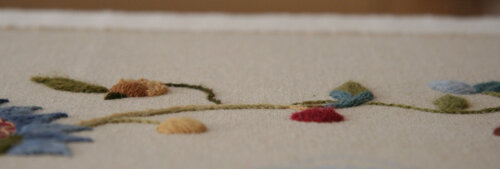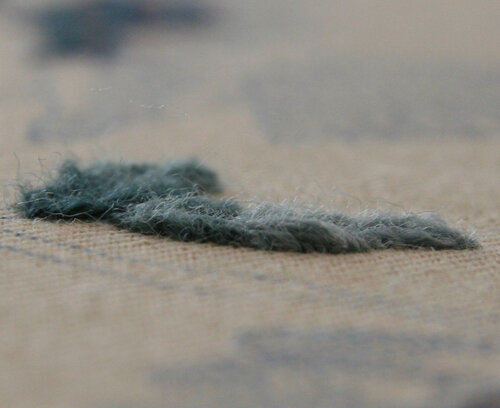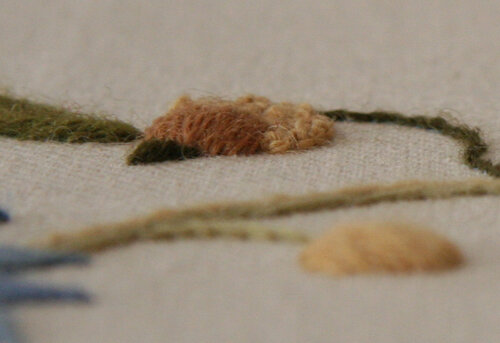Texture and two threads
As I continued to work on the beautiful Marriage Pillowe late this week, I was struck with the texture of the piece. There is a three dimensional quality to it that is quite different from the other crewel work piece I'm stitching right now. Part of this is because I'm using Heathway wool for the other piece and Heathway is a more finely spun wool than Appleton. The other reason is that the stitching for the Marriage Pillowe calls for using two threads for all of the berries, acorns and leaves. Using two threads creates a three dimensional landscape of stitching. The berries and acorns become hills and the leaves become long mountain ranges. The single thread stem stitch looks like a small, raised road traveling across the linen from hill to mountain.Within the leaves, the double threads create even more texture. The middle anchoring stitch in closed fly, when worked with two threads, makes a deep valley in the mountain range.
Using two threads creates a three dimensional landscape of stitching. The berries and acorns become hills and the leaves become long mountain ranges. The single thread stem stitch looks like a small, raised road traveling across the linen from hill to mountain.Within the leaves, the double threads create even more texture. The middle anchoring stitch in closed fly, when worked with two threads, makes a deep valley in the mountain range. The little berries, which are padded satin stitch, are very raised up off the linen twill. They look plump and delicious, just like a berry should look.
The little berries, which are padded satin stitch, are very raised up off the linen twill. They look plump and delicious, just like a berry should look. The acorn is done with padded satin stitch, using two threads for both the padding and the stitch. This means it's "4 threads high". The French knots and the bottom point are done using two threads so their height isn't as great. It's a great contrast of texture and makes me want to touch the stitching.
The acorn is done with padded satin stitch, using two threads for both the padding and the stitch. This means it's "4 threads high". The French knots and the bottom point are done using two threads so their height isn't as great. It's a great contrast of texture and makes me want to touch the stitching. When this piece is finished, I would imagine that it will be one that people pick up and touch, rather than simply look at from afar. The texture is irresistible. It's accentuated by the large areas of linen twill that are left plain, so the contrast is greater.I'm not sure how to decided when and where to use two threads instead of one in my own designs. Is it up to the discretion of the designer? Is there an historical basis for the choice of one or two threads? If anyone has any answers or ideas, I'd love to know.
When this piece is finished, I would imagine that it will be one that people pick up and touch, rather than simply look at from afar. The texture is irresistible. It's accentuated by the large areas of linen twill that are left plain, so the contrast is greater.I'm not sure how to decided when and where to use two threads instead of one in my own designs. Is it up to the discretion of the designer? Is there an historical basis for the choice of one or two threads? If anyone has any answers or ideas, I'd love to know.
